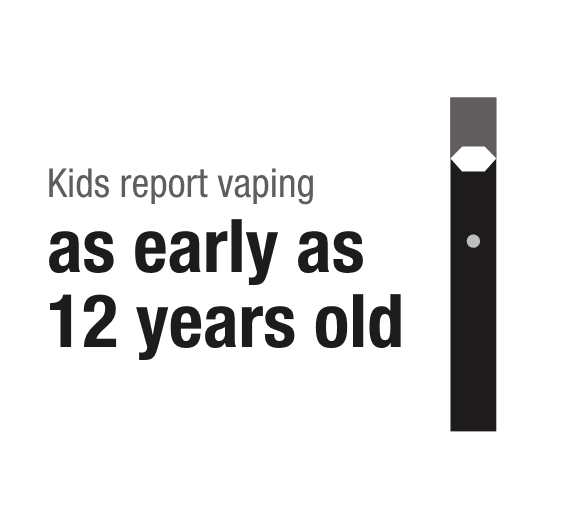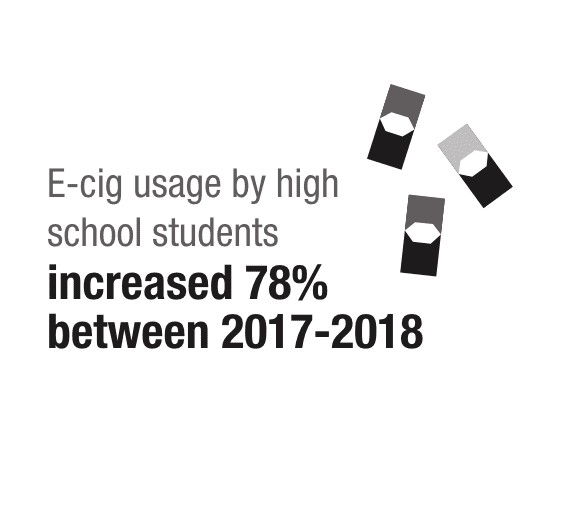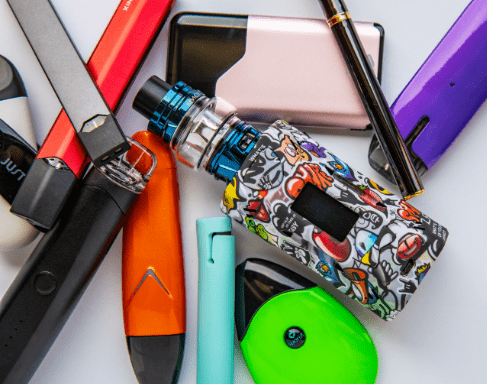As cigarette use declines worldwide, Big Tobacco has expanded its offerings to include new products. Vapor products are one of the most alarming and threatening products from this generational shift. These products, often referred to as e-cigarettes, vapes, or by brand names such as Elf Bar, are using false marketing claims, trendy designs and nuanced issues to push addiction and mask the dangers of vaping on millions of young and unsuspecting customers.
Vapes are battery-powered devices that heat liquid for vapor inhalation. A product initially pitched as a cessation tool quickly evolved into a new harmful industry.
The Dangers of Vaping
Most people think of vapes as a safer alternative to cigarettes. The truth is the average vape contains more nicotine than cigarettes — some contain double the amount of a pack of cigarettes. The dangers of vaping extend beyond nicotine — several other toxic chemicals in vapes can have long-lasting and disruptive health effects. A list of common ingredients includes but is not limited to:
- Carcinogens – chemicals known to cause cancer, including acetaldehyde and formaldehyde.
- Acrolein – an herbicide used to kill weeds that can cause irreversible lung damage.
- Diacetyl – a major ingredient in flavored vapes that is linked to lung disease or “popcorn lung.”
- Cadmium – a chemical found in traditional cigarettes that causes breathing problems.
- Propylene glycol – a food additive used to make paint solvents, antifreeze and artificial smoke.
Health Effects
According to the Surgeon General’s website, the dangers of vaping go beyond the chemicals listed above — vaping also contains ultrafine particles of lead, nickel and tin. The puff emitted from a vape is NOT just water vapor — it’s a toxic aerosol. All these toxic chemicals, carcinogens, flavors and metals pass through the lungs with every inhale.
Vapes have been around for over a decade but are still considered a relatively new product. Experts are conducting research to grasp a full understanding of the long-term and short-term dangers of vaping, but here’s what we know so far:
- “Popcorn lung,” caused by diacetyl, is another name for bronchiolitis obliterans (BO), which happens when the lungs’ small airways are damaged. This can result in inflammation of the lungs and permanent scarring, as well as coughing, wheezing and shortness of breath.
- Vaping-related pneumonia happens when the thick, oily liquid from vape juice builds up inside the lungs.
- In severe cases, vaping can also result in a collapsed lung. The harsh chemicals can irritate blisters inside the lung, resulting in a burst — a hole forms, allowing oxygen to escape into the body.
- Other common health struggles include headaches, dry mouth, eye irritation and bad breath.
These are just a few health risks caused by vape ingredients. Nicotine, the addictive substance in vapes, comes with additional health struggles.
Mental Health
In addition to the physical toll, vaping can also affect the brain. For years, we’ve known that nicotine, including synthetic nicotine, can have lifelong effects on mental health, especially on developing brains. Even small doses of nicotine can greatly affect teens’ mental health. Today, research is revealing serious and immediate mental health risks associated with nicotine use among teens, including:
- Learning difficulties
- Mood swings
- Anxiety
- Impulsivity
- Depression
For many, it starts with the mood-altering effects of nicotine. Nicotine can have an appealing impact on consumers’ attention and concentration, as well as masking mental health symptoms or medication side effects. Once nicotine takes hold, many fear the symptoms of nicotine withdrawal. For people who experience panic attacks, withdrawing from nicotine increases the heart rate, which can trigger an attack and contribute to the fear of quitting. However, understanding the true impact nicotine has on mental health is the first step in breaking the cycle of addiction.
Youth
The dangers of vaping become especially troubling when kids and teens are in the mix. With an array of flavors and visually appealing designs, vaping products have grabbed the attention of middle and high school students nationwide.
- In Oklahoma, 1 in 5 (21.7%) high school students uses vape products — double the national average of 1 in 10.
- In 2022, nearly 9 out of 10 underage vape users exclusively used flavored products.
- Nearly half (43%) of youth who vape have admitted to trying a device because they were intrigued by the flavor, smell or design.
Recently, Big Tobacco has used the design of vapes in scary and threatening ways. Lax age-verification laws make it possible for teens to buy vapes and other nicotine products online. A new trend, “discreet” shipping through social media, is also adding fuel to the fire as underage shoppers buy products hidden in cosmetic bags, tech boxes and more.


False advertising
Central to the dangers of vaping is deceptive marketing. Vape companies shamelessly exploit mental health struggles in their marketing with promises of relief and escape. This insidious lie is only made worse by the facts mentioned above — that nicotine only worsens mental health struggles, the problems they claim to alleviate. Another common lie is that vapes are “safer” than cigarettes. Marketing campaigns highlight their differing ingredients and lack of tobacco. However, this false portrayal loses steam when compared to the facts: many kids do not use vapes as cessation. They start with vapes.
Finally, online marketing through influencers and social media takes vapes mainstream. Young people in the U.S. are spending more time online than ever before, and the dangers of vaping are hidden behind a smokescreen. Social media platforms such as TikTok play a significant role in the promotion of vapes — from professional product placement to PR packages — filling the small screens of teens and young adults with unhealthy temptation.
Protecting the Public
In 2016, the Food and Drug Administration (FDA) was granted authority to regulate all tobacco products, including vapes. The federal regulations include:
- Minimum age restriction
- Requirements to include a nicotine warning
- Required disclosure of existing health information, including a list of ingredients and health effects
While these efforts have helped make the dangers of vaping a wider-known issue, Big Tobacco is great at finding loopholes.
With the growing popularity still on the rise, it takes everyone working toward a smokefree and vapefree future to protect our community. There has never been a better time to talk to your kids, no matter their age. Find conversation guides and answers to hard questions here. You can also work to bring that change to a larger scale. Make a positive change in your community by taking to your own social media, writing to a legislature and more at our Get Involved page.
If you or someone you know is thinking about quitting vaping, reach out to the Oklahoma Tobacco Helpline for free, nonjudgmental support. Call 1-800-QUIT NOW, visit OKhelpline.com or text READY to 34191 to get started.












